Advertisements
Advertisements
Question
Mention if the following statement is true (T) or false (F) Give reason.
Short-sightedness and hyperopia are one and the same thing
Options
True
False
Solution
False
short-sightedness is myopia and hyperopia is long-sightedness.
APPEARS IN
RELATED QUESTIONS
Name the part of the eye:
which controls the amount of light entering the eye.
What do the ciliary muscles do when you are focusing on a nearby object?
What happens to the eye when you enter a darkened cinema hall from bright sunshine? Give reason for your answer.
The descriptions of five kinds of images are given below:
(a) diminished and virtual
(b) enlarged and real
(c) enlarged and erect
(d) real and inverted
(e) virtual and the same size
Which one of these describes the image formed:
(i) on the retina of the eye?
(ii) by a magnifying glass?
(iii) by a convex driving mirror on a car?
(iv) by a plane mirror?
(v) on the screen of a slide projector?
fill in the following blank with suitable word:
A person is short-sighted if his eyeball is too............Spectacles with a .............lens are needed. A person is long-sighted if his eyeball is too............Spectacles with a ................lens are needed. These focus light rays exactly on to the..........
Name the following:
The photoreceptors found in the retina of the eye.
Give scientific reason:
We cannot clearly see an object kept at a distance less than 25 cm from the eye.
The diagram alongside represents a certain defect of vision of the human eye.
(i) Name the defect.
(ii) Describe briefly the condition in the eye responsible for the defect.
(iii) Redraw the figure by adding a suitable lens correcting the defect. Label the parts through which light-rays pass.
(iv) What special advantage do human beings derive in having both eyes facing forward?
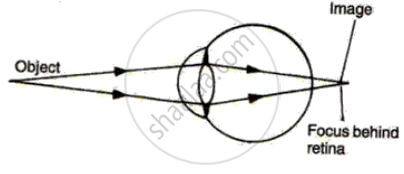
Differentiate between:
Retina and Choroid.
Name the following:
Yellow spot and ciliary muscles are found in.
Name the following:
The type of lens used for correcting myopia.
State the Location:
Iris
State the Function:
Vitreous humour
A prism ABC (with BC as base) is placed in different orientations. A narrow beam of white light is incident on the prism as shown in Figure . In which of the following cases, after dispersion, the third colour from the top corresponds to the colour of the sky?
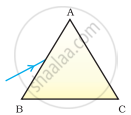 |
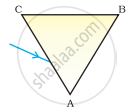 |
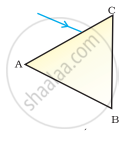 |
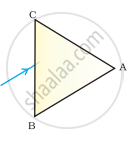 |
| (i) | (ii) | (iii) | (iv) |
Which part of the eye gets affected if someone is suffering from cataract? How is it treated?
Match the following:
| Column - I | Column - II | ||
| 1 |
Retina |
a | Pathway of light |
| 2 | Pupil | b |
Far point comes closer |
| 3 | Ciliary muscles | c |
near point moves away |
| 4 | Myopia | d | Screen of the eye |
| 5 | Hypermetropia | f | Power of accommodation |
Match the following:
| Column - I | Column - II |
| 1. Retina | a. Path way of light |
| 2. Pupil | b. Far point comes closer |
| 3. Ciliary muscles | c. near point moves away |
| 4. Myopia | d. Screen of the eye |
| 5. Hypermetropia | e. Power of accommodation |
Match the following:
| Column - I | Column - II | ||
| 1 | Retina | a | Path way of light |
| 2 | Pupil | b | Far point comes closer |
| 3 | Ciliary muscles | c | near point moves away |
| 4 | Myopia | d | Screen of the eye |
| 5 | Hypermetropoia | e | Power of accomodation |
Match the following:
|
Column - I |
Column - II | ||
| 1 | Retina | a | Path way of light |
| 2 | Pupil | b |
far point comes closer |
| 3 | Ciliary muscles | c |
near point moves away |
| 4 | Myopia | d | Screen of the eye |
| 5 | Hypermetropia | e | Power of accommodation |
The layer in the eye where sensory cells (rods and cones) are located ______.
